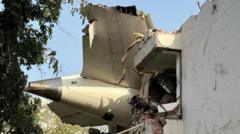Are Boeing Fuel Switches Safe After the Air India Crash?

Understanding the Safety Concerns of Fuel Control Switches in Boeing Airplanes
The aviation industry is one of the most meticulously regulated sectors globally. Safety is paramount, and every incident is investigated thoroughly to ensure future improvements. The recent tragic crash of Air India Flight 171, which resulted in the loss of 260 lives, has raised significant safety questions regarding the fuel control switches in Boeing aircraft. Following the preliminary investigation into this disaster, the U.S. Federal Aviation Administration (FAA) has stated that these switches are safe, but the implications of this assertion remain a key discussion point in aviation safety circles. In this article, we will explore the details of the crash, the FAA's response, and broader implications for aviation safety.
The Tragic Incident: Air India Flight 171
On a fateful day in June, Air India Flight 171 took off from Ahmedabad airport, bound for London Gatwick. The Boeing 787-8 Dreamliner, a modern aircraft boasting advanced technology, was expected to ensure a safe journey. However, within moments of take-off, disaster struck. The aircraft crashed into a medical college near the airport, resulting in one of the worst aviation incidents in almost a decade.
Details of the Crash
According to the preliminary report released by the India Aircraft Accident Investigation Branch (AAIB), the plane's fuel to the engines was abruptly cut off shortly after take-off. This crucial event hampered the aircraft's thrust, leading to the loss of control. Investigators revealed that the switches controlling the fuel flow had moved from the "run" position to "cut-off." This shift occurred almost simultaneously, raising numerous questions about how such an event could happen during flight.
Eyewitness accounts and recovered cockpit voice recordings indicated a troubling exchange between the pilots, where one questioned the other about the fuel cutoff. This revelation has intensified scrutiny surrounding the design and safety features of fuel control switches in Boeing airplanes.
The FAA's Assessment of Fuel Control Switches
In the wake of the crash, the FAA responded to the concerns raised by the AAIB. The agency noted its awareness of the preliminary findings and emphasized the importance of safety in aviation. However, the FAA maintains that it does not consider the fuel control switch issue an unsafe condition warranting an Airworthiness Directive for any Boeing model, including the 787 Dreamliner.
Historical Context: FAA Advisory and Inspections
The FAA had previously issued a non-mandatory advisory in 2018, recommending operators of Boeing aircraft to inspect the fuel control switches' locking features. This advisory was based on reports indicating that some switches were installed with the locking feature disengaged, which could lead to accidental movement. The AAIB's preliminary report indicated that Air India had not acted on this advisory, raising questions about compliance with safety recommendations.
Key Takeaways from the FAA’s Position
The FAA's position can be summarized as follows:
- The agency has reviewed the AAIB's preliminary report and continues to monitor the situation closely.
- Despite the concerns raised, the FAA does not consider the fuel control switch design to pose an unsafe condition requiring immediate regulatory action.
- Ongoing communication and information sharing with international civil aviation authorities will be maintained to ensure global aviation safety standards are upheld.
The Implications of the Investigation
The investigation into Air India Flight 171 is expected to take up to 12 months, during which comprehensive findings will be released. This period will be critical in establishing not only the cause of the crash but also in determining any necessary changes to safety protocols. The implications of these findings could be profound for the aviation industry, as they may lead to revised regulations and increased scrutiny of aircraft safety features.
Potential Regulatory Changes
As investigations continue, there is a possibility that the FAA and other aviation authorities may reevaluate existing guidelines concerning fuel control switches and other critical safety features. Possible outcomes could include:
- Mandatory inspections of fuel control switch locking features across all Boeing models.
- Enhanced pilot training focused on handling fuel control mechanisms.
- Increased reporting requirements for airlines regarding maintenance and inspection of critical systems.
Broader Safety Concerns in Aviation
The crash of Flight 171 highlights broader safety concerns in the aviation industry beyond the specific issues of fuel control switches. It serves as a reminder that even modern aircraft with advanced technology are not immune to tragic accidents. The aviation sector must continuously evolve to prioritize safety.
Human Factors in Aviation Safety
One aspect that the investigation may delve into is the role of human factors in aviation safety. The interaction between pilots, their training, and their decision-making processes can significantly impact flight safety. Understanding how human error contributes to incidents can lead to enhanced training programs and protocols aimed at minimizing such risks.
Technological Advances and Safety Features
As technology improves, so do the safety features integrated into aircraft. However, the effectiveness of these features relies heavily on proper implementation and adherence to safety guidelines. The aviation industry must ensure that technological advancements are complemented by rigorous training and compliance checks to maximize safety.
Conclusion: The Road Ahead for Aviation Safety
The tragic crash of Air India Flight 171 serves as a grim reminder of the importance of safety in aviation. While the FAA has deemed the fuel control switches safe, the investigation remains ongoing and could lead to critical changes in regulations and safety practices. The focus on safety must be relentless, as the stakes are incredibly high. With every aviation incident, the industry has an opportunity to learn and improve, ensuring that the safety of passengers remains the top priority.
As the investigation continues, one must wonder: how can the aviation industry ensure that such a tragedy never happens again? The answer may lie in learning from past mistakes, adhering to safety protocols, and fostering a culture of safety within the industry.
FAQs
What caused the crash of Air India Flight 171?
The preliminary report indicates that the fuel to the engines was cut off shortly after take-off due to the fuel control switches being moved to the "cut-off" position, hampering thrust and control of the aircraft.
What is the FAA's position on fuel control switches in Boeing aircraft?
The FAA has stated that it does not consider the fuel control switch issue to be an unsafe condition warranting regulatory action, despite recommending inspections in a 2018 advisory.
How long will the investigation into the crash take?
The full investigation is expected to take up to 12 months, during which comprehensive findings will be released regarding the causes of the crash and recommendations for future safety improvements.
As we navigate the complexities of aviation safety, what steps do you think should be taken to enhance the reliability and security of our skies? #AviationSafety #Boeing #AirIndiaFlight171
Published: 2025-07-14 05:57:53 | Category: technology



